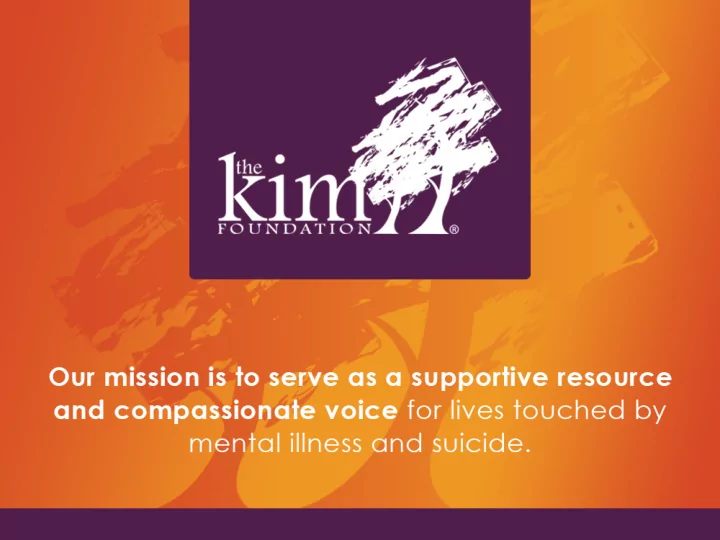

Place Title Here
The Kim Foundation o Founded in honor of Larry Courtnage’s Daughter, Kim o We strive to: 1. Connect people to resources 2. Provide grants to local non-profits 3. Increase awareness about mental health and suicide prevention Larry and Kathy Courtnage Family 4. Break down stigma often associated with seeking mental health care
Our Connection
National Suicide Data
2017 National Suicide Statistics o 47,173 Suicide Deaths o 1,400,000 Suicide Attempts o Suicide & Self-Injury cost the US $69 Billion - 2015 o Men died by suicide 3.54x more often than women o White males account for 69.67% of suicide deaths o Firearms account for 50.57% of all suicide deaths o 90% vs 54% of those who die by suicide had an underlying mental health condition AFSP.org
2017 Indiana Suicide Statistics o On average 1 suicide death every 8 hours o Suicide is the 2 nd leading cause of death for 15-34 year olds o 4 th leading cause of death of 35-54 year olds o 1,092 total suicide deaths o Suicide cost Indiana a total of $1,023,791,000 combined lifetime medical & work loss cost in 2010 o Nearly 5x as many people died by suicide than in alcohol related motor vehicle accidents AFSP.org
Interesting Facts - Nebraska o Comparisons between Indiana & Nebraska o NE population – 1.929 million o IN population – 6.692 million o NE – car accidents/suicide o NE – homicides/suicide o What do Indiana’s numbers look like? AFSP.org
Other Data o Estimated 300-400 doctors die by suicide each year o More than double that of the general population o Burnout, one factor o Jeopardizing medical license o Care and service for others o National movements to address issue led by the Federation of State Medical Boards through recommendations (though no mandates) o Up to each facility to prioritize employees’ mental well-being
Language o Why does language matter? o People first language o Mental Illness/Mental Health Challenge/Disorder/Condition o Slang words to describe mental illness o Non-verbal communication o Committed suicide or died by suicide?
Successes We’ve Seen o 13 Minutes – unique components o LOSS Data o Monitor Trends o 2017 – 10 youth suicide deaths o Targeted prevention messaging to youth o 2018 – 4 youth suicide deaths o 2018 – 10 less overall suicide deaths in our community (99/89) o Using numbers/data to determine success o https://www.13minutes.org/Videos.html
IHA Resources o Suicide Prevention Toolkit https://www.ihaconnect.org/_layouts/15/WopiFrame.aspx?sourcedoc={AF242AA2- 9AD5-4CDB-B310-3B18FC8B6289}&file=Suicide%20Awareness%20Toolkit- final.pdf&action=default&DefaultItemOpen=125 o Offered Zero Suicide Academy (11 orgs attended) o Continued support for rural & critical access hospitals through Small Rural Hospital Improvement Program (SHIP) o Suicide Ideation Data through Datalink o Statewide involvement at Council on Behavioral Health & Council on Quality & Patient Safety meetings
Other Indiana Resources o Multiple LOSS Teams o 25 Support & Community Resources online o www.pfw.edu o Purdue Suicide Prevention resources o Opportunities for hospitals to move beyond your walls & into the community o What can you do in your community?
Questions to Consider o Does your facility have suicide prevention policies? o Does your facility have suicide postvention policies? o Do you know what postvention is? o Are you in a position of leadership at your facility? o If you do have policies pertaining to suicide, have you communicated those with your entire staff? o Do they believe in your support and priority of saving lives from suicide, just as heart, cancer, etc? o Do your employees know self-care is a priority and something they have your/leadership’s support in practicing?
Further Considerations o Creating thoughtful, impactful policies o Often requires cultural/organizational change o Who should be at the table to create these policies? o Administration/board must be there o Not only be there, but buy in 100% and share that message
Organizational Change o Transformational/Radical Change o Incremental Change o Developmental Change o Remedial Change o Process & System Change o People & Cultural Change
Organizational Change o 70% of change initiatives fail o Negative Employee Attitudes o Unproductive management behavior o Clearly define your change o How does it align with your existing business goals? o Communication Strategy o Productive & effective training & support to implement change Pulselearning.com
National Best Practices o Integrated care o CCBHC’s (Certified Community Behavioral Health Centers) o Expands access to mental health & addiction care in community based setting o Since 2018, Congress has appropriated funds for 2 year expansion grants, including Indiana o Currently operating in 21 states
National Best Practices o Zero Suicide o Founded in the belief that suicide deaths for those under the care of health & behavioral health systems are preventable o Essentially improving patient safety/quality improvement o System wide transformation toward safe suicide care o Addresses a sometimes fragmented & distracted health care system o https://zerosuicide.sprc.org/
Other Resources o SAMHSA – National Strategy for Suicide Prevention Implementation Assessment Report o Assessments & Screeners System Wide o https://suicidepreventionlifeline.org/best-practices/ o Health Affairs Article - https://www.healthaffairs.org/doi/full/10.1377/hlthaff.2015.1672 o National Action Alliance for Suicide Prevention https://theactionalliance.org/
Where Do We Go From Here? o Each of us plays a role o What level of change is your facility going to require? o Sound policies truly do work o Communicate the clearly & effectively o Follow National Best Practices, or evidence based practices o Your community needs you
Questions? Julia Hebenstreit, J.D. Executive Director The Kim Foundation jhebenstreit@thekimfoundation.org 402.891.6997
Recommend
More recommend